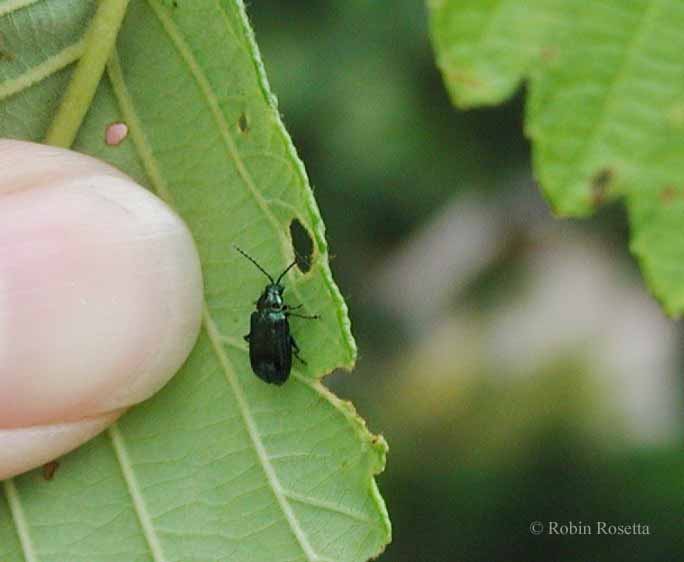Alder flea beetle, Macrohaltica ambiens (= Altica ambiens), is a chrysomelid beetle which can skeletonize the leaves of its host trees. Both adults and larvae feed on the foliage. There is one generation a year. The adult beetles overwinter in the duff at the base of the plants. They emerge in the late spring/summer (mid-June in 2007 and as early as the beginning of May in 2013), mate, and lay their eggs on the undersides of the leaves. The larvae appear shortly after, reaching maturity in August. The larvae then drop and pupate in pupal chambers in the soil below the leaf litter. The pupal stage lasts about 10 days. The adults emerge and feed on the leaves in August.
Alder is listed as the main host of this plant. Although management in landscapes is probably not required, nursery growers might approach alder flea beetle management similar to management of other skeletonizing flea beetles such as elm leaf beetle. Researchers (Alfaro et al. 1981) have found that western red cedar leaf oil also showed antifeedant activity with the alder flea beetle.
Web links:
Alfaro, RI, Pierce, HD Jr., Borden, JH., Oehlschlager, AC. 1981. Insect feeding and oviposition deterrents from western red cedar foliage. J Chem Ecol. 1981 Jan;7(1):39-48. doi: 10.1007/BF00988634. <accessed 4 April 2016>
One of the most informative websites on this beetle is the website, Alder leaf beetle management, from Forest Health Protection and State Forestry Organizations
Original publication: June 2007
Last update: 4-4-2016
Author: R.L. Rosetta, Extension Nursery Integrated Pest Management, Department of Horticulture, Oregon State University
Page last modified 4/4/16
Alder damaged by alder flea beetle - note damage starting at base of tree
Alder flea beetle damage
Alder flea beetle damage
Fully skeletonized leaves as a result of flea beetle feeding
Alder flea beetle larvae feeding on leaf underside
Closeup of alder flea beetle larva
Alder flea beetle adult







